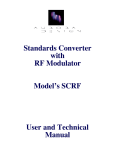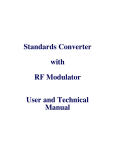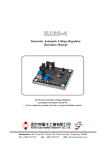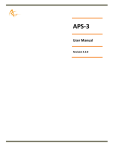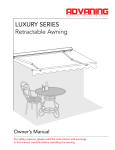Download SC_downloads_files/Single User Manual 1.0
Transcript
Standards Converter for Mechanical Television Model’s SC User and Technical Manual Copyright 2006-9 Aurora Design LLC. Revision 1.0 23 April, 2007 All specifications subject to change www.tech-retro.com Introduction Introduction This manual covers the operation and technical aspects of the Single-Standard Converter for mechanical television. The Converter is designed to accept an NTSC or PAL/SECAM video signal and convert to one of several different output standards depending on the model. The converted video is sent to a composite video output connector. Due to the nature of mechanical television it is assume that the user has a good understanding of what is required to operate such a device in conjunction with this converter, such as an ppropriate lamp (Neon, LED, etc) and a lamp driver that accepts the video output signal from this converter. No attempt is made in this document to describe such a driver and it’s operation. Features • Compact, low power, surface mount design • Front panel Status LED • Internal user switch selectable options control • Extremely stable output: +/- 3% levels, +/- 50ppm timing • Output clock line locked to input clock for perfect conversions • 10 bit video D/A for greater than 54dB dynamic range • 100K gate equivalent FieldProgrammableGateArray • EEPROM memory for FPGA firmware, field upgradeable • Extremely accurate algorithms used for conversions • Two full frame memory for stable output regardless of input • Automatic Sleep Mode for low power standby operation • Versatile I/O: - Composite Video Input (NTSC/PAL, 1Vpp, 75 ohm) - Composite Video Output (various standards depending on model, 1Vpp, 75 ohm) - DC power (7-14Vdc, 100ma) 3 Introduction Front Panel The front panel is shown below: Composite Video Input Status LED Composite Video Input: The Composite video input signal required depends on the operating mode and model of the converter. A video source conforming to the NTSC or PAL/SECAM video standards must be supplied to the Composite (RCA or BNC) input connector. The unit accepts either standard, selectable through an internal option switch. Status LED: The status LED conveys the current operating state of the converter. Slow Flashing: No video input signal detected. Default image will be output. Solid: Converter locked to video input. Normal operation. Pulsating: Converter in low power Sleep mode. 4 Introduction Rear Panel The rear panel is shown below: Composite Video Output 9Vdc Input Composite Video Output: This RCA or BNC connector provides the video output from the converter. This output should terminate into a 75 ohm load. For complete information about the characteristics of this output, please refer to the Specifications section found later in this manual. This output will typically connect to a user supplied lamp driver for the mechanical television. Power: The converter requires a power source of between 7.0 and 14 volts DC at 100 mA. A 9 volt DC power supply is recommended to reduce power consumption. Voltages over 16 volts will damage the unit. The unit has a reverse polarity diode in series with the input, so it will not be damaged by reversal of polarity. The unit uses a standard 2.1mm X 5.5mm, center positive, coaxial power connector as found on most consumer electronic equipment. Internal Options The internal Options switch and AM Audio RF Carrier control are shown below: 5 R30 1 2 3 4 ON R10 R9 Back of unit (Outputs) S1 R8 L2 Introduction Programing Port R3 U1 Option Switch U2 C32 R4 Front of unit (Inputs / LED) The internal Option Switch S1 has four controls allowing the user to set the operating mode of the converter. In order to change the switch settings, the cover must be removed from the unit. To do this, first remove all cables from the unit, including the power cable. Place the unit on it’s top, and remove the two, small phillips screws from the bottom. Flip the unit back over, and remove the top. Caution! In the subsequent steps, make sure you are touching one of the outer metal rings on the phono or RF connectors to discharge any static electricity that may be present before proceeding. There are static sensitive devices inside the converter that can be damage if subjected to a static discharge. Failure to follow this procedure will result in damage to the unit! Using a small tool such as a paper clip, carefully slide the desired switch to it’s new position being careful to not put an undue amount of force on the switch that might damage it or the circuit board. Once the desired switch settings have been achieved, replace the cover on the unit, and reinstall the two phillips screws. Position 1 - Input Standard Select: This switch is used to control the Input Standard of the converter. In the OFF position the converter will accept a PAL input video signal. In the ON position the converter will accept a NTSC input video signal. 6 Introduction Position 2 - Output Standard Select: This switch is used to control the Output Standard of the converter. For the SC30/32 model, in the OFF position a 32/12.5p NBTV type signal is output. This includes the appropriate line and frame sync signals. In the ON position a 30/12.5p Baird type signal is output. This includes the three elongated pixels on each side of the image. Position 3 - Output Invert: This switch is used to select the output mode of the converter between normal and inverted. In the OFF position the converter will output a normal, positive video signal. In the ON position the converter will invert the output. This can be useful to match the polarity of the external lamp driver. Position 4 - Output Gamma: This switch is used to select the output mode of the converter between gamma correted and straight video. Since modern video is pre-corrected at the source to compensate for the gamma of CRT’s, and since most lamps used for mechanical television are linear (Neon, LED, etc) gamma correction needs to be provided to correct the video. This feature performs the correction accurately in the converter so it is not required in the lamp driver. In the OFF position the internal gamma correction is eneabled. In the ON position the internal gamma correction is disabled. Operating Modes Normal Full Operating Mode: When valid video is present the Status LED will show a Solid light, and the unit will output converted video on the composite output connector. This is the most common operating mode. Default Mode: When no valid video is connected to the composite input, the unit will output a default image. This can be used to verify operation of the unit, or aid in setup of the television. Sleep Mode: Since no power switch is supplied on this unit, an automatic Sleep Mode will be 7 Introduction entered whenever the video input is not present for more than 1 hour. With this feature, the standards converter is shut down, along with the video output. Only the video decoder is left active to signal when a valid video input is again supplied to the unit to wake it up. Typical Connections In normal usage, a user supplied power adapter is connected to the converter and to the AC power source. A valid NTSC or PAL/SECAM video source should also be connected to the video input. The video source can be anything from a VCR to a DVD to an off-air broadcast. The video output can then be connected to the input of a user suplied lamp driver. This driver needs to take the video output signal from the converter and power the apropriate lamp. (Neon, LED, etc). The driver should provide for brightness (level) and contrast (gain) controls to adjust the video signal for proper operation of the lamp. The brightness control can be used to properly setup for blacks while the contrast control can setup for peak whites. Typically some means of synchronization is required for the television to avoid having the user constantly adjuat the speed and phase of the motor to keep the image centered and phased. For the NBTV standard, this is done through the insertion of standard type line sync pulses in the video, with the pulse missing on line one for frame synchronization. A properly equipped NBTV television will lock the the output of the converter with no other adjustments necissary. For televisions like the Baird which used an AC/DC motor and a snychronous phonic coil, the video output signal from the comnverter needs to be filtered and fed through an appropriate amplifier to the phonic coils on the television. This will lock the television to the converter but the user will still need to phase (center) the image manually. Since the converter contains multiple full frames of video memory, the output signal will always be stable regardless of the video input signal. Normally a mechanical television would require relocking and rephasing each time the video input signal changed, but the converter eliminates this entirely. Once the television is locked to the conveter, it should remain so. The use of high quality video cables is recommended for best results. Cables conforming to 75 ohm impedance should be used on the video inputs and outputs. If all the above steps have been properly performed, there should now be a solid status light on the front panel of the converter indicating a locked video signal as described previously, and a stable image on the television. To help aid in setup, when no video input is presented to the converter, it will output a default image. This can be useful in making final adjustments to the television. Video content is important to consider when dealing with mechanical televisions due to the small size and low resolution. Close ups that are centered in the video make for better viewing on the mechanical television. For standards with low aspect ratio such as Baird (3:7) and NBTV (2:3) only the center protion of the input video is converted to maintain the correct ratio. 8 Introduction Theory of Operation In order to convert between different video standards, spatial and temporal correction are required. Spatial correction involves changing the resolution, size and aspect ratio of the incoming video to the output video format. This can be easily achieved through standard digital methods utilizing scalers and FIR filters. This will be discussed in detail. Temporal correction involves changing the frame rate of the incoming video to match the outgoing video. It was decided that no off the shelf components existed that would provide the desired functionality, so a FieldProgrammableGateArray, or FPGA, was chosen to provide all the digital functionality. By adding input/output circuitry, memory, and ancillary circuitry to the FPGA, the entire system could be realized. The basic building blocks to the design are; FPGA, video decoder (ADC), and multiple power supplies. A brief description of each part follows: FPGA: Xilinx XC3S100E-4VQ100 100K gate equivalent 72Kb block RAM 1.2V Core / 2.5V Aux / 3.3V I/O Video Decoder: TI TVP5150A 9bit ADC’s, 2X Over-Sampled Line Locked Clock 4 Line Adaptive Comb Filter Multiplexed 8bit YCrCb output bus Video DAC: Proprietary Design 10bit effective DAC 35 MSPS maximum conversion rate 56 dB SNRs Topology A block diagram of the circuitry is shown below: Composite Input Video ADC and Decoder FPGA Field Memory 9 Video PLL Video DAC, Filter and Driver Composite Output Introduction The incoming video is digitized and processed by the TVP5150A using a 14.318MHz reference crystal to the ITU-601 (formerly known as CCIR601) specification. All internal timing is generated using this crystal. The video is quantized, processed for brightness, contrast, chroma gain and hue, among others, and output at the ITU rate of 27MHz on an 8 bit, time multiplexed bus, with alternating luma and chroma samples. No other signals are required from this circuit as the ITU specification describes a method for encrypting the horizontal and vertical timing information directly into the digital data using timing reference makers, or TRS codes. A brief description of the ITU-601/656 specification is as follows: Fundamental quantization frequency: 13.5MHz Pixel Resolution: 720 H x 486 V NTSC / 720 H x 576 PAL Image Aspect Ratio: 4:3 Pixel Aspect Ratio: 1.1 NTSC / 0.9 PAL Horizontal Frequency: 15,734 Hz NTSC / 15,625 Hz PAL Vertical Frequency: 29.97 Hz NTSC / 25 Hz PAL Clocks per Line: 1716 NTSC / 1728 PAL (27MHz clock) Clocks per Frame: 900900 NTSC / 1080000 PAL (27 MHz clock) Note that the vertical frequency is 29.97Hz for NTSC, not 30Hz as expected. This is due to the NTSC color system that was first ratified in 1953. All monochrome television transmissions prior to this standard used exactly 30Hz, or 30 frames per second, so as to be in sync with the AC line frequency. This is done to reduce distortions in the image due to induced AC fields or “hum” from the power supplies of these early sets. In order to devise a “compatible” color system that would show a monochrome signal on existing sets, RCA proposed a method of modulating the color components of the video signal onto a subcarrier in the video. For reasons beyond the scope of this manual, a frequency needed to be chosen so that no standing patterns in the color signal would result. This required lowering the vertical frequency from 30Hz to 29.97Hz. While this change caused no adverse side effects on televisions, it has created a legacy of problems for modern video equipment. Instead of being able to use integer numbers like 24, 25 and 30, we now have to include 29.97 which makes many calculations and conversion extremely difficult. For digital processing, the ratio 1000/1001 has been established as the conversion between 30 and 29.97 video. The digital video data is then routed to the FPGA where it is further processed. The data is sent to the internal field memory in round robin fashion. The field memory is large enough to hold two frames of video, so there is always enough data to keep an uninterrupted flow to the output. The video data is scaled prior to storing in the field memories. This scaling is done with a multi-tap FIR filter for the horizontal downscaling, and averaging for the vertical. Extra processing like that to stretch the outer three pixels on each side of a Baird image is also done at this time. All processing is done synchronous to the ITU clock. Since this clock is much higher than required for mechanical television rates, it is also used to generate the output video. Using the same ITU clock, a video timing generator, or flywheel is 10 Introduction created in the FPGA to generate all timing signals for the model’s output standard. All horizontal, vertical, pixel count and line count generation is done in this process. This is the main “heartbeat” process for the entire design. Using these timing signals, the video data that was stored in the field memory synchronous to the incoming ITU video clock can now be clocked out. With all the above timing now generated, the output video can be created. The signals from the flywheel are routed to the video output DAC at the appropriate times in the signal, while the processed video from the partial-field memory is routed to the video DAC during the active portions of the video signal. The DAC is run at a two times over sampled rate to reduce filtering requirements, and increase SNR. The video is then filtered and buffered before being sent to the composite output connector. Updating Firmware If it ever becomes necessary to update the firmware in the unit, this can be accomplished through the programming port next to the Option Switch as previously shown. The connector is a standard 8 pin, double row, 2mm connector. A custom cable with a mating connector is used in conjunction with a Xilinx Parallel III, Parallel IV or USB Platform download cable and the appropriate software. A full description of the hardware, software, and procedure to FLASH the unit can be found in the supplemental programming guide for the converter. 11 Specifications Specifications Video Input: Supported Standards: NTSC 29.97fps / PAL 25fps / SECAM 25fps Video Quantization: 9bit A/D, 8 bit data Video Input: Composite - 1Vpp, 75 ohm impedance Video Output: Video Output: Composite - 1Vpp into 75 ohms Video Quantization: 10 bit Effective D/A Video Levels: +/- 3% of output standard Video Timing: +/- 50 ppm, Line/PLL locked, < 2ns jitter typical Video SNR: 56dB typical General: Dimensions: 2.60” X 2.60” X 1.00” (66mm X 66mm X 25mm) Weight: 2.0oz (57g) Power Requirements: 9Vdc typical, 7-14Vdc maximum 1.0 watts typical (Full Operation) 0.75 watt typical (Sleep Mode) Humidity: 20% - 80% non-condensing Temperature: 10C - 45C ambient (50F - 110F) 12 Supported Conversions Supported Conversions NTSC/PAL to 32/12.5p NBTV: Image / Pixel Aspect Ratios: Pixel Clock: Active Pixels / Lines: 2:3 / 0.33 27.0 MHz 32 (cropped 60) / 120 - NTSC Input 32 (cropped 60) / 125 - PAL Input Horizontal / Vertical Frequency: 12.488 Hz / 400 Hz - NTSC Input 12.5 Hz / 400 Hz - PAL Input Scan Type: Mechanical Progressive Bottom to Top, Right to Left Video Characteristics: 26 KHz, 1Vpp into 75 ohms 70/30 video/sync ratio NTSC/PAL to 30/12.5p Baird: Image / Pixel Aspect Ratios: Pixel Clock: Active Pixels / Lines: 3:7 / 0.49 27.0 MHz 30 (cropped 90) / 120 - NTSC Input 30 (cropped 90) / 125 - PAL Input Horizontal / Vertical Frequency: 12.488 Hz / 375 Hz - NTSC Input 12.5 Hz / 375 Hz - PAL Input Scan Type: Mechanical Progressive Bottom to Top, Right to Left Video Characteristics: 25s KHz, 1Vpp into 75 ohms 13 Available Models Available Models Model No. SC30/32 NTSC/PAL to 30/12.5p Baird and 32/12.5p NBTV 14 Firmware Revision History Firmware Revision History Revision 1.0, April 23, 2007: 1) Initial release. Note: Hardware/Firmware revision level can be found on bottom label of unit. 15















